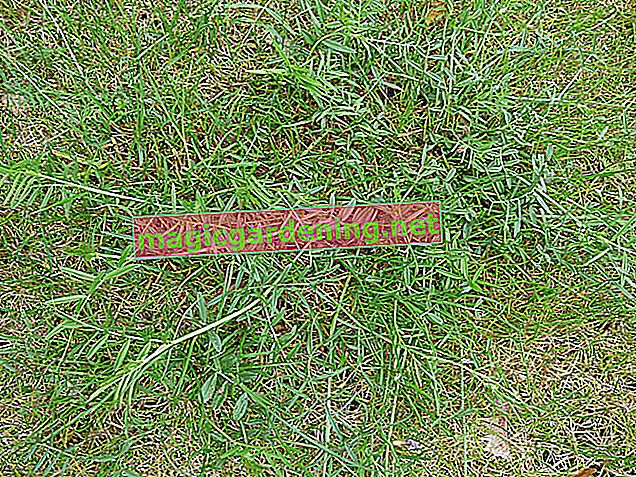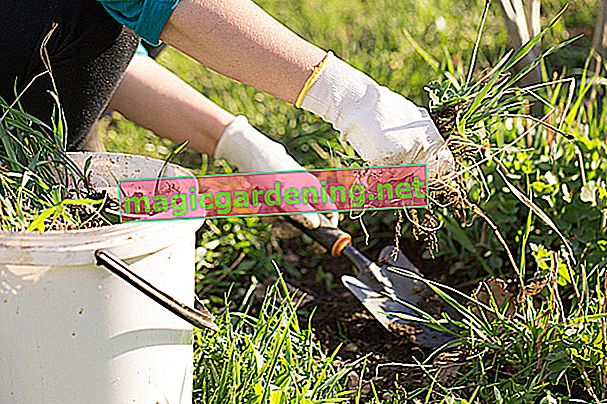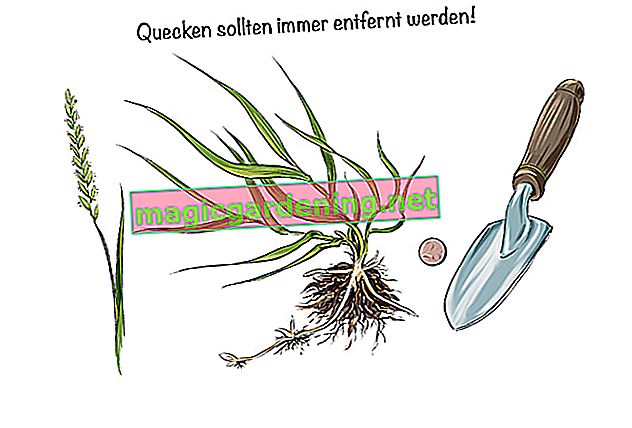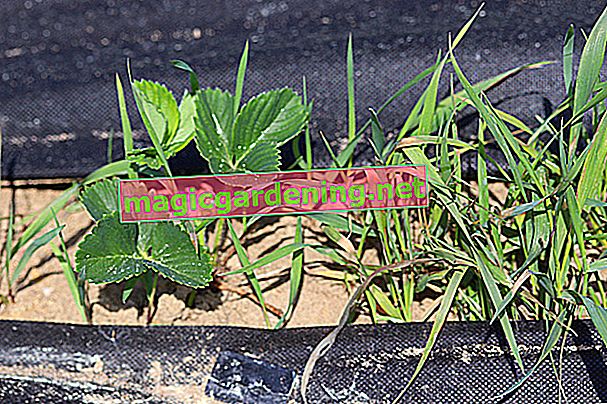
the essentials in brief
- There are different types of couch grass, only the common or creeping couch grass poses a problem in the garden. Others either do not form rhizomes or are even important for the dune reinforcement.
- The couch grass is a pioneer plant that quickly colonizes fallow land and spreads rapidly. It forms meter-long rhizomes from which numerous new plants grow.
- From the smallest pieces of rhizome new couch grass develop, which makes the plant so difficult to control.
- The best method is to dig up couch grass over and over and keep it from being seeded. How to starve the weeds out.
Fight couch grass successfully
YoutubeIf you want to fight couch grass successfully, you have to roll up your sleeves and be patient. The best way to get rid of or contain the weeds is to dig them up over and over or cut off the above-ground parts of the plant. This weakens the plant and prevents it from spreading further. Incidentally, it is particularly important not to allow the plant to bloom in the first place and thus to seed it. In this way, you gradually starve the weeds out and hopefully get rid of them after one or two growing seasons.
also read
- Fighting couch grass - this is how you get rid of the root weeds
- Six tips on how to successfully control weeds in the garden
- Fight chickweed successfully
Mechanical methods

The best way to remove couch grass is by lifting the clumpy growing plant out of the ground with the help of a digging fork and carefully removing all roots as possible. To do this, you have to pull the long, mostly flat runners out of the earth. Make sure that the roots don't tear off and that you actually catch every piece, no matter how short. This procedure is easiest on previously unplanted areas that are to be reclaimed. Go here bit by bit and take each couch potato individually. Fortunately, a soil interspersed with couch grass roots is usually quite loose from the start.
In beds and borders interspersed with couch grass, on the other hand, it has proven useful to first dig up the actual plants, carefully remove any bits of couch grass from their roots, and only then work the bed systematically as described. Only when the bed is “drained” do you plant it again. In the follow-up care it is immensely important to put a stop to the spread of weeds from the outset. You can do this by covering the bed with a thick layer of mulch (for example from bark mulch) and immediately removing any plants that come through regularly.
Cover
In general, a lack of light is important to get rid of couch grass. Many a gardener swears by practically starving the plants, for example with a cover made of weed foil or corrugated cardboard. Corrugated cardboard in particular is an environmentally friendly method, as it naturally rots within a year and therefore does not leave behind any problematic waste - as is the case with plastic film. And that's how it works:
- Remove the couch grass manually as already described.
- Now cover the wasteland closely with corrugated cardboard.
- A thin layer of bark mulch or soil is placed on the corrugated cardboard.
- Leave the area fallow for 12 months.
- Then clear them up.
- Most of the corrugated cardboard should be rotten.
The couch grass roots should also be killed and not sprout again. That this can happen anyway shouldn't come as a surprise due to the survival power of the plants. Note that after such a treatment, the soil must be carefully fertilized. The rotting cardboard draws nutrients from the soil that you need to add back - ideally with organic fertilizers such as compost. In this way you stimulate the microbial life of the soil again.
Incidentally, planted areas can also be starved in the manner described. To do this, you only have to cover the non-planted areas and simply leave the appropriate recesses free where the ornamental or useful plants are.
Fight couch potatoes with potatoes?

Occasionally, it is advisable to first plant potatoes on a bed that has been freed from couch grass. Due to their dense canopy of leaves, these would rob the couch grass of the light and thus prevent the weeds from growing again. Although this method sounds very promising, it just doesn't work in the practical test. On the contrary: If the couch grass and its roots are not removed from the bed thoroughly enough, the new shoots often feel particularly good in a pot bed. Ergo you can not avoid regular weeding afterwards.
It is better to first sow the worked bed with rapidly growing green manure. This actually suppresses the couch grass growth and at the same time ensures that you create the right foundations for a new planting. For this purpose, however, avoid legumes if possible, as these primarily enrich the soil with nitrogen and thus also promote the couch grass. Instead, winter vetch, which is sown in autumn, is very suitable. Even a dense cover of nasturtiums can literally suppress couch grass. The corresponding bed should not be worked on in the next year, but should remain densely planted.
Digression
With Jerusalem artichoke against couch grass
Jerusalem artichoke - a sunflower plant with edible tubers - is also said to drive away couch grass. In the spring, simply plant Jerusalem artichokes on a cleared bed that has been freed from couch grass and wait to see what happens.Herbicides
Glyphosate-based herbicides, such as the infamous RoundUp and other chemical weed killers, are the last secret weapon of gardeners plagued by quecks. Think carefully about the use, however, because on the one hand such total herbicides do not differentiate between undesired and desired plants - instead they simply flatten everything if you are not careful - and on the other hand, these remedies are simple and highly toxic both for you and your family, for Pets and farm animals as well as for your garden.
Glyphosate in particular is considered to be highly carcinogenic and therefore has no place in the home garden. If you still want to use a herbicide, it is best to apply it in warm and dry weather. Make sure that you only spray the weeds so that you don't accidentally kill your garden vegetation. Then you have to wait a bit, because these agents must first be absorbed by the plants before they can develop their deadly effect.
Do home remedies help against couch grass?
Many a gardener swears by household remedies such as vinegar, salt or simply boiling water to combat couch grass. In fact, these methods can be quite successful, but have serious disadvantages.
Vinegar and salt
First of all, plain household vinegar or vinegar essence is a popular household remedy. Dilute the table vinegar in a ratio of 1:15 (one part vinegar, 15 parts water) and spray or water the plant to be controlled directly. Since vinegar essence is more concentrated, you need to add more water in this case. Make sure that you only wet the couch grass with the vinegar, as this cannot distinguish between desirable and undesired plants. The same applies to salt: You can use one part of normal household salt and five parts of hot water to make your own herbicide, which you apply directly to the plant.
The couch grass treated with it attack after a few days together with its roots and can then be removed. Thus, these remedies are very effective, but also have negative effects on the environment:
- Soil acidified by vinegar - low pH, poor plant growth
- when using salt, the salt remains in the soil - salinization inhibits plant growth
- neither vinegar nor salt can be removed from the soil
- both are only degraded over a long period of time
- disturb the microbial life in the soil and thus the formation of humus
- can get into the groundwater
In view of these disadvantages, the use of both vinegar and salt is not recommended. After all, these substances are not harmless just because they are labeled “home remedies”.
Boiling water

Instead of vinegar and salt, you can simply use boiling water and scald the couch grass with it. The weeds will definitely not survive this treatment and will die. But be careful: Boiling water does not contain any ingredients that are harmful to the soil, but due to its high temperature it is still a sensitive disturbance to the life of the soil. For this reason it is better not to use this method; the microorganisms that are so important for humus formation will thank you for it.
Digression
Use of home remedies is prohibited on paved surfaces
Incidentally, the use of agents such as salt and vinegar on sealed and non-agricultural areas - such as on terraces, driveways and sidewalks - is prohibited by law and can result in heavy fines.What can be done against couch grass in the lawn?

Of course the couch grass occurs more frequently in the lawn, although it is not noticeable here at first - after all, it is also a grass that, embedded in the lawn grass, is practically invisible in it. Many gardeners only become aware when strikingly light, quite wide blades of grass snuggle between the otherwise dark green grass. If you don't want to use a herbicide, it is best to simply prick the couch grass with a digging fork and pull out the rhizomes as carefully as possible. For this purpose, you can first lift off the turf, which contains mercury, with a spade, remove the weeds and then put them back in the lawn. You sow free areas again.
Regular mowing - once a week - during the growing season as well as balanced fertilization and watering ensure that the couch grass cannot grow in the first place. Installed lawn edges and root barriers also ensure that the weeds stay outside and do not grow into the lawn from outside.
Prevent couch grass growth

Little is known that the couch grass plague is often brought in - for example through inferior or contaminated lawn seeds. When re-seeding the lawn and doing repair work, be sure to buy high-quality mixtures. In particular, the cheap “no-name mixes” from the discounter as well as some supposedly inexpensive bargains from the Internet are to be urgently avoided in this regard.
In addition, couch grass often grows into the garden from neighboring fields or meadows. In order to prevent the weeds from spreading further, barrier measures such as lawn edges and the like are sensible. The same applies to vegetable and ornamental beds, in which, conversely, the couch grass should not grow out of the meadow. By the way: Horse and cattle manure (€ 17.80 at Amazon *) is a great garden fertilizer, but it is often also a carrier of couch grass seeds. The animals love to eat the grass (which is why it is also grown as animal feed in some countries, such as Finland), but they do not digest the seeds. These pass through the digestive tract undamaged and then germinate in the garden. Pig manure, on the other hand, is not a problem.
To avoid a couch grass plague in the garden, you should use these measures:
- Do not over-fertilize garden soil, especially not with nitrogen
- Dig up couch grass early (before sowing!)
- do not pack on top of the compost
- not undermine
- Install lawn edges and other growth barriers
- do not fertilize with horse or cattle manure (at least not with which from unclear sources)
- use high quality seeds (lawn)
The couch grass - a stubborn root weed
“Know your enemy” is the saying as well as aptly - this is especially true for couch grass. Because if you want to fight this herb successfully, you should know its biology and, above all, have seen through its survival strategies.
Queck belong to the so-called ear grasses and thus also to the sweet grasses. In contrast to many other types of grass, however, they are undesirable in the garden because they form meter-long rhizomes. These run through the garden soil, are difficult to remove and also ensure that the weeds can hardly be removed. A new plant can grow from every piece, no matter how small.
species

When hearing the word “couch grass” the gardener thinks primarily and above all of the widespread and stubborn weeds that make life and gardening difficult for him with its meter-long rhizomes. What is hardly known, however, is that there are between 40 and 100 different species - depending on the system - that are distributed across almost the entire northern hemisphere. Not all of these ear grasses form the characteristic rhizomes for which the garden mercury is actually known. The so-called Hundsquecken (bot. Roegneria), for example, get along completely without and reproduce exclusively through their seeds.
In addition, not all couch grass species are weeds, some are, in contrast, immensely important. This applies above all to the sand or dune whirlpools native to the coastal areas of northern Germany, which are intended to consolidate the dunes and loose sandy soils and thus protect them from erosion and sand removal (e.g. by the sea and wind). Thus, there are sometimes great differences between the various species, but they all have in common their strong urge to spread and the ability to displace other plants. This is where the name of this grass genus comes from, because the Old High German word “queck” means something like “lively” or “strong”.
The following table provides a brief overview of the most important species of couch grass in Germany.
| Couch grass | Scientific name | Occurrence and distribution | Locations | Runners | particularities |
|---|---|---|---|---|---|
| Common couch grass / creeping couch grass | Elymus repens ssp. repens | Europe, North America, North Africa, Siberia | widespread, both on nutrient-poor and nutrient-rich soils | yes, pronounced | most common type of couch grass, widespread weed |
| Dog mercury | Elymus caninus | Europe, Asia, North America, New Zealand | at the edges of the forest and in bushes | No | widespread |
| Beach couch grass / beach wheat | Elymus farctus | Europe, North America, North Africa, Western Asia | on sandy soils, mainly on dunes (coastal areas) | Yes | important for the stability and consolidation of sand dunes |
| Dense-eared couch grass / sand couch grass | lymus athericus | Central European coastal areas, North and Baltic Sea coasts | on sandy soils | Yes | important for the stability and consolidation of sand dunes |
features
So basically only the common or creeping couch grass is of interest to the gardener. You can easily recognize this perennial ear grass by the following characteristics:
- meter-long, branching, underground root runners
- typically light to white in color
- Most of the roots run flat under the ground
- Rhizomes penetrate up to 80 centimeters deep
- clumpy growth above ground
- upright stalks between 50 and 150 centimeters high
- Up to 150 new plants can grow from a single plant per year
The flowering period of the couch grass is between June and August. During this time, the two-row, loose flower spikes, which are mostly gray-green in color, appear. Couch grass can be found on almost all soils, but they prefer a dense and nutrient-rich subsoil. This is the reason why weeds feel so comfortable in the garden: Here they find well-fertilized soil and all other amenities.
Couches are typical pioneer plants that spread quickly on fallow land. However, they have a high need for light and can be suppressed by the targeted planting of shading plants (such as bushes).
Multiplication and distribution
Couches multiply through their subterranean runners as well as through seeding. The gardener is particularly interested in the information that although the plant is able to sprout from the smallest pieces of rhizome over and over again, these specimens grown from them are not as vigorous and assertive as the “original” plant. By continually chopping, digging up and pulling out, you weaken the couch grass so that the vegetation can be slowly but effectively contained.
But be careful when working the soil: The small pieces of rhizome can be distributed throughout the garden through gardening such as digging and the like - one reason why plucked or dug up couch grass plants have no place on the compost. With a little bit of bad luck, use half-ripe compost to spread the remaining bits of root in freshly dug up and prepared beds. Just like the roots, the seeds of the plant are also very resilient: They are still capable of germinating at a depth of up to five centimeters and remain so for up to ten years - this becomes problematic if you deeply sow couch grass buried in the ground.
Tips
Be careful not to over-fertilize the garden soil! In particular, over-fertilization with nitrogen promotes the growth of couch grass, because the plants are less viable on poor ground.
Couch grass as a medicinal plant?
"Don't be angry about couch grass, you better make something of it!"
Yes, you read that right: the common couch grass has been used, at least in folk medicine, for many centuries. The health-promoting properties of other wild herbs and weeds have been known for a long time, and many people also know that dandelions, daisies and ground grass are great to eat in the salad. But the couch grass? In fact, in earlier times, weeds were used as vegetables or as a substitute for flour, especially when there was not much to eat due to a lack of food. The starchy roots, for example, can be dried and ground into flour, which can then be used to stretch conventional grain flour.The roots as well as the leaves and stalks can be prepared as vegetables in the soup - this still happens today, for example, in the rural kitchens of the former CIS countries.
Ingredients and possible uses
Mercury roots in particular contain saponins (soap substances), as well as silica, potassium salts and various vitamins and carbohydrates. In the past, the plant was mainly used for so-called flushing therapies, as it is considered to be diuretic and blood-purifying. This is how bacterial infections should be treated earlier. Nowadays, however, such use must be discouraged. On the one hand, the effect attributed to couch grass has not been researched, and such self-treatments can simply lead to the inflammation only getting worse.
frequently asked Questions
What is the difference between root and seed weeds?
Roughly speaking, the difference between seed weeds and root weeds is that seed weeds spread primarily through seeding and root weeds spread through their roots. Naturally, seed weeds are - mostly, but not always - easier to control, after all, you don't have to pull meter-long rhizomes out of the garden soil.
Typical seed weeds are, for example, chickweed (bot. Stellaria media), white goose foot (bot. Chenopodium album), ribwort (bot. Plantago lanceolata) or the annual bluegrass (bot. Poa annua). The root weeds include groundweed (bot. Aegopodium podagraria), Gundermann (bot. Glechoma hederacea), creeping buttercup (bot. Ranunculus repens), horsetail (bot. Equisetum), bindweed (bot. Convolvulaceae) and, of course, couch grass. Other plants, on the other hand, cannot be clearly assigned, but are both seed and root weeds.
What is the best way to control seed weeds?
The best way to control seed weeds is to keep weeding them - if possible before the seeds ripen and are spread. It is therefore best not to wait for it to bloom in the first place, but rather pluck as soon as you see one of these herbs. The seeds can remain viable for years even in adverse conditions and sprout - distributed by wind and animals - in the most impossible places.
Isn't there a simple method that is sure to help against couch grass and other root weeds?
The removal of root weeds such as couch grass can easily take on the proportions of a new hobby, but not one that is enjoyed. However, there is no easy way to master the herb - if there were, its inventor would certainly have become very rich. Despite all the suggestions, the best way to control it is still to dig up the plants and all of their roots if possible. If you see it positively, that might make your work easier: This way you save yourself the gym.
What if I just don't do anything against couch grass and Co.?
Of course, this is also a possibility, but it carries a great risk: stubborn root weeds tend to displace other plants in no time due to their vigor. We know of couch grass, for example, that not only do they grow quickly and the soil is quickly dense with their roots, but that they also release enzymes that in turn inhibit the growth of other plants. Ergo, you have no choice but to deal with this stubborn plant again and again - only then do you have a chance that something else will grow in your garden or lawn.
Tips
Giersch is just as stubborn as couch grass, which is why the methods of control described here can also be applied to this weed. The same applies to groundweed: Be persistent and dig - that's the only thing that is really effective against root weeds.








